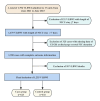An investigation into the impact of family integrated care on extrauterine growth restriction at discharge in very low birth weight infants: a multi-centre study
- PMID: 40785514
- PMCID: PMC12336925
- DOI: 10.7189/jogh.15.04168
An investigation into the impact of family integrated care on extrauterine growth restriction at discharge in very low birth weight infants: a multi-centre study
Abstract
Background: Family integrated care (FIC) encourages parental involvement in neonatal intensive care units (NICU) and has been found to promote weight gain in preterm infants. Extrauterine growth restriction (EUGR) results from inadequate growth among very low birth weight infants (VLBWI), which has been found to contribute to parental anxiety. To address an existing gap in research, we aimed to examine the impact of parental involvement on EUGR at discharge in VLBWI.
Methods: We conducted a retrospective, multi-centre case-control study involving VLBWIs admitted to 17 NICUs across eight southeastern Chinese provinces and cities from February 2021 to November 2023. We categorised cases and control groups based on the presence of EUGR at discharge and compared their perinatal and hospitalisation characteristics, as well as FIC duration, using a generalised linear mixed model.
Results: EUGR in VLBWI at discharge was associated with birth weight (odds ratio (OR) = 0.547; 95% confidence interval (CI) = 0.490, 0.610), gestational week (<28 weeks) (OR = 3.101; 95% CI = 1.909, 5.038), Apgar score at 1 minute ≤7 (OR = 1.525; 95% CI = 1.119, 2.079), being small for gestational age (OR = 3.269; 95% CI = 1.547, 6.908), maternal gestational hypertension (OR = 1.868; 95% CI = 1.270, 2.748), necrotising enterocolitis (OR = 2.254; 95% CI = 1.386, 3.667), and total FIC duration. Based on literature and clinical practice, we divided the total FIC duration into three groups. We found that the lowest OR was associated with >18 hours of care, followed by ≤18 hours, while the highest was associated with 0 hours of care.
Conclusions: We identified higher birth weight and FIC as protective factors against EUGR at discharge in VLBWI. In contrast, we recognised gestational age <28 weeks, an Apgar score ≤7 at 1 minute, small for gestational age, maternal gestational hypertension, and necrotising enterocolitis as risk factors. Nevertheless, further research is required to analyse the relationship between FIC and EUGR at discharge.
Registration: ClinicalTrials.gov (NCT06550440).
Copyright © 2025 by the Journal of Global Health. All rights reserved.
Conflict of interest statement
Disclosure of interest: The authors completed the ICMJE Disclosure of Interest Form (available upon request from the corresponding author) and disclose no relevant interests.
Figures



Similar articles
-
Noise or sound management in the neonatal intensive care unit for preterm or very low birth weight infants.Cochrane Database Syst Rev. 2024 May 30;5(5):CD010333. doi: 10.1002/14651858.CD010333.pub4. Cochrane Database Syst Rev. 2024. PMID: 38813836 Free PMC article.
-
Sound reduction management in the neonatal intensive care unit for preterm or very low birth weight infants.Cochrane Database Syst Rev. 2015 Jan 30;1:CD010333. doi: 10.1002/14651858.CD010333.pub2. Cochrane Database Syst Rev. 2015. Update in: Cochrane Database Syst Rev. 2020 Jan 27;1:CD010333. doi: 10.1002/14651858.CD010333.pub3. PMID: 25633155 Updated.
-
Planned birth at or near term for improving health outcomes for pregnant women with gestational diabetes and their infants.Cochrane Database Syst Rev. 2018 Jan 5;1(1):CD012910. doi: 10.1002/14651858.CD012910. Cochrane Database Syst Rev. 2018. PMID: 29303230 Free PMC article.
-
Higher versus lower amino acid intake in parenteral nutrition for newborn infants.Cochrane Database Syst Rev. 2018 Mar 5;3(3):CD005949. doi: 10.1002/14651858.CD005949.pub2. Cochrane Database Syst Rev. 2018. PMID: 29505664 Free PMC article.
-
Metformin for women who are overweight or obese during pregnancy for improving maternal and infant outcomes.Cochrane Database Syst Rev. 2018 Jul 24;7(7):CD010564. doi: 10.1002/14651858.CD010564.pub2. Cochrane Database Syst Rev. 2018. PMID: 30039871 Free PMC article.
References
-
- Multicenter Study Collaborative Group for Evaluation of Outcomes in Very Low Birth Weight Infants [Risk factors for extrauterine growth retardation in very low birth weight infants: a multicenter study]. Zhonghua Er Ke Za Zhi. 2020;58:653–60. Chinese. - PubMed
Publication types
MeSH terms
Associated data
LinkOut - more resources
Full Text Sources
Medical
Miscellaneous
